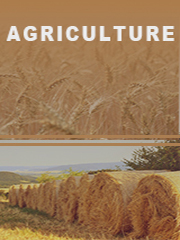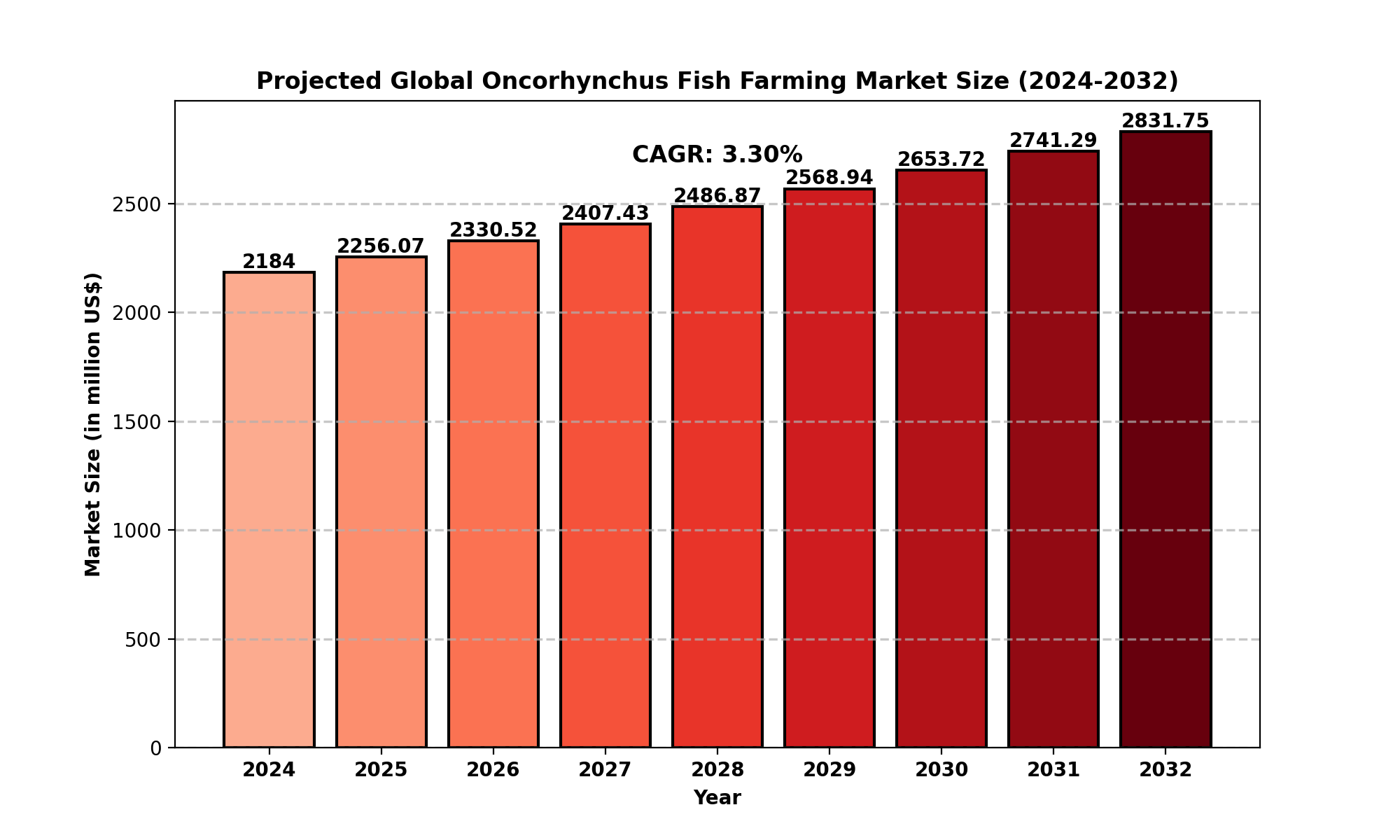TOP CATEGORY: Chemicals & Materials | Life Sciences | Banking & Finance | ICT Media

Download Report PDF Instantly
Report overview
Oncorhynchus fish farming refers to the aquaculture of specific salmonid species belonging to the Oncorhynchus genus, including coho salmon (Oncorhynchus kisutch), rainbow trout (Oncorhynchus mykiss), and chinook salmon (Oncorhynchus tshawytscha). It is a subset of fish farming that focuses on raising these species in controlled environments, such as tanks, net pens, or open-water systems, to meet the increasing global demand for salmon. While Atlantic salmon (Salmo salar) dominates the overall salmon farming industry, Oncorhynchus species represent a critical segment, especially in regions where local preferences and environmental conditions favor their cultivation.
This method involves advanced aquaculture technologies and practices to ensure optimal fish growth, health, and sustainability while addressing environmental concerns. Key products of Oncorhynchus fish farming are used in the food industry, especially in processed forms like fillets, smoked salmon, and sushi-grade fish.
Market Size
The global Oncorhynchus Fish Farming market was valued at approximately USD 2,184 million in 2024 and is forecasted to reach USD 2,831.75 million by 2032, growing at a compound annual growth rate (CAGR) of 3.30% during the forecast period.
North America held a significant share, with its market size estimated at USD 601.74 million in 2024. The region is expected to experience steady growth at a CAGR of 2.83% through 2032, driven by advancements in aquaculture technologies, increasing demand for sustainable seafood, and government policies supporting fish farming practices.
Globally, the demand for Oncorhynchus fish farming is being fueled by rising seafood consumption, driven by its nutritional benefits, including high protein content, omega-3 fatty acids, and essential vitamins. The growing awareness of sustainable and eco-friendly fish farming practices further boosts the industry's expansion.

Market Dynamics (Drivers, Restraints, Opportunities, and Challenges)
Drivers
Increasing Seafood Consumption: With a global shift toward healthier diets, seafood consumption has risen significantly. Oncorhynchus fish, particularly coho salmon and rainbow trout, are sought after for their high nutritional value.
Sustainable Aquaculture Practices: As consumers become more environmentally conscious, demand for sustainably farmed seafood, including Oncorhynchus species, has increased.
Advancements in Aquaculture Technology: Innovations such as recirculating aquaculture systems (RAS) and offshore farming techniques have improved production efficiency and fish health.
Government Support and Policies: Regulatory frameworks in key regions promote sustainable aquaculture practices, boosting investments in Oncorhynchus fish farming.
Restraints
High Initial Investment Costs: Setting up modern fish farming facilities with advanced technologies requires significant capital investment.
Environmental Concerns: Issues such as water pollution, habitat degradation, and disease outbreaks in aquaculture systems remain challenges.
Market Competition: The dominance of Atlantic salmon farming often overshadows Oncorhynchus fish farming, limiting market penetration in some regions.
Opportunities
Rising Demand for Organic and Sustainable Products: Organic-certified fish farming practices present a lucrative opportunity for market growth.
Expansion in Emerging Markets: Developing countries in Asia-Pacific and South America show growing demand for Oncorhynchus fish products.
Value-Added Products: Opportunities exist to develop and market processed fish products such as smoked fillets, ready-to-cook meals, and gourmet seafood items.
Challenges
Climate Change Impact: Rising water temperatures and changing ocean conditions pose risks to aquaculture systems.
Disease Management: Outbreaks of diseases like sea lice and bacterial infections can significantly affect fish health and yield.
Regulatory Compliance: Meeting stringent aquaculture regulations across different regions can be a complex and costly process.
Regional Analysis
North America
North America is a key player in the Oncorhynchus fish farming market, driven by high consumer demand for seafood and government incentives for sustainable aquaculture. The United States and Canada are leading contributors, leveraging advanced technologies to enhance productivity and maintain environmental standards.
Europe
Europe has shown steady growth due to increased consumption of salmon and trout. Countries like Norway, Scotland, and Germany play pivotal roles in the region's aquaculture sector. Efforts to reduce environmental impact and adopt organic fish farming practices are gaining momentum.
Asia-Pacific
Asia-Pacific represents a rapidly growing market, with China, Japan, and South Korea leading the way. The region's growing population, rising disposable incomes, and expanding seafood industry drive demand for Oncorhynchus fish farming.
South America
Chile dominates South America's aquaculture industry, particularly in salmon farming. The region benefits from favorable climatic conditions and robust export markets, particularly to North America and Europe.
Middle East and Africa
While still developing, the Middle East and Africa region shows potential for growth in aquaculture due to increasing investments in food security and sustainable farming practices.
Competitor Analysis (in brief)
The Oncorhynchus Fish Farming market is characterized by several key players:
Mowi ASA: A global leader in aquaculture, focusing on sustainable salmon farming.
SalMar: Known for innovative fish farming techniques, particularly in Norway.
Cermaq (Mitsubishi): A major producer with a strong emphasis on sustainability.
Leroy Seafood Group: Specializes in high-quality salmon and trout products.
Empresas Aquachile: A leading salmon exporter from Chile.
Grieg Seafood: Focuses on sustainable farming practices across multiple regions.
Cooke Aquaculture: A vertically integrated seafood company with a diverse product portfolio.
Bakkafrost: A Faroese company known for high-quality salmon production.
Market Segmentation (by Application)
Food Processing Plants: The largest consumer of farmed Oncorhynchus fish, used in the production of ready-to-eat and processed seafood products.
Hotels: Demand is driven by the hospitality sector for high-quality fish for gourmet dishes.
Supermarkets: Retail chains stock a variety of farmed salmon and trout products to meet consumer demand.
Other: Includes direct sales to restaurants, fish markets, and small-scale distributors.
Market Segmentation (by Type)
Atlantic Salmon Farming: Accounts for the majority of the market, driven by high demand and established farming practices.
Pacific Salmon Farming: Includes coho, chinook, and other Oncorhynchus species, catering to niche markets and regional preferences.
Key Company
Mowi ASA
SalMar
Cermaq (Mitsubishi)
Leroy Seafood Group
Empresas Aquachile
Grieg Seafood
Salmones Multiexport
Cooke Aquaculture
Bakkafrost
Geographic Segmentation
North America: USA, Canada, Mexico
Europe: Germany, UK, France, Russia, Italy, Rest of Europe
Asia-Pacific: China, Japan, South Korea, India, Southeast Asia, Rest of Asia-Pacific
South America: Brazil, Argentina, Columbia, Rest of South America
Middle East and Africa: Saudi Arabia, UAE, Egypt, Nigeria, South Africa, Rest of MEA
FAQ Section
What is the current market size of the Oncorhynchus Fish Farming market?
The global market was valued at USD 2,184 million in 2024 and is projected to reach USD 2,925.20 million by 2032.
Which are the key companies operating in the Oncorhynchus Fish Farming market?
Key players include Mowi ASA, SalMar, Cermaq (Mitsubishi), Leroy Seafood Group, and Empresas Aquachile, among others.
What are the key growth drivers in the Oncorhynchus Fish Farming market?
Drivers include increasing seafood consumption, advancements in aquaculture technology, and rising demand for sustainable fish farming practices.
Which regions dominate the Oncorhynchus Fish Farming market?
North America, Europe, and Asia-Pacific are the dominant regions in this market.
What are the emerging trends in the Oncorhynchus Fish Farming market?
Emerging trends include organic fish farming, adoption of advanced technologies like RAS, and increasing focus on value-added seafood products.
Key Benefits of This Market Research:
Industry drivers, restraints, and opportunities covered in the study
Neutral perspective on the market performance
Recent industry trends and developments
Competitive landscape & strategies of key players
Potential & niche segments and regions exhibiting promising growth covered
Historical, current, and projected market size, in terms of value
In-depth analysis of the Oncorhynchus Fish Farming Market
Overview of the regional outlook of the Oncorhynchus Fish Farming Market:
Key Reasons to Buy this Report:
Access to date statistics compiled by our researchers. These provide you with historical and forecast data, which is analyzed to tell you why your market is set to change
This enables you to anticipate market changes to remain ahead of your competitors
You will be able to copy data from the Excel spreadsheet straight into your marketing plans, business presentations, or other strategic documents
The concise analysis, clear graph, and table format will enable you to pinpoint the information you require quickly
Provision of market value data for each segment and sub-segment
Indicates the region and segment that is expected to witness the fastest growth as well as to dominate the market
Analysis by geography highlighting the consumption of the product/service in the region as well as indicating the factors that are affecting the market within each region
Competitive landscape which incorporates the market ranking of the major players, along with new service/product launches, partnerships, business expansions, and acquisitions in the past five years of companies profiled
Extensive company profiles comprising of company overview, company insights, product benchmarking, and SWOT analysis for the major market players
The current as well as the future market outlook of the industry concerning recent developments which involve growth opportunities and drivers as well as challenges and restraints of both emerging as well as developed regions
Includes in-depth analysis of the market from various perspectives through Porter